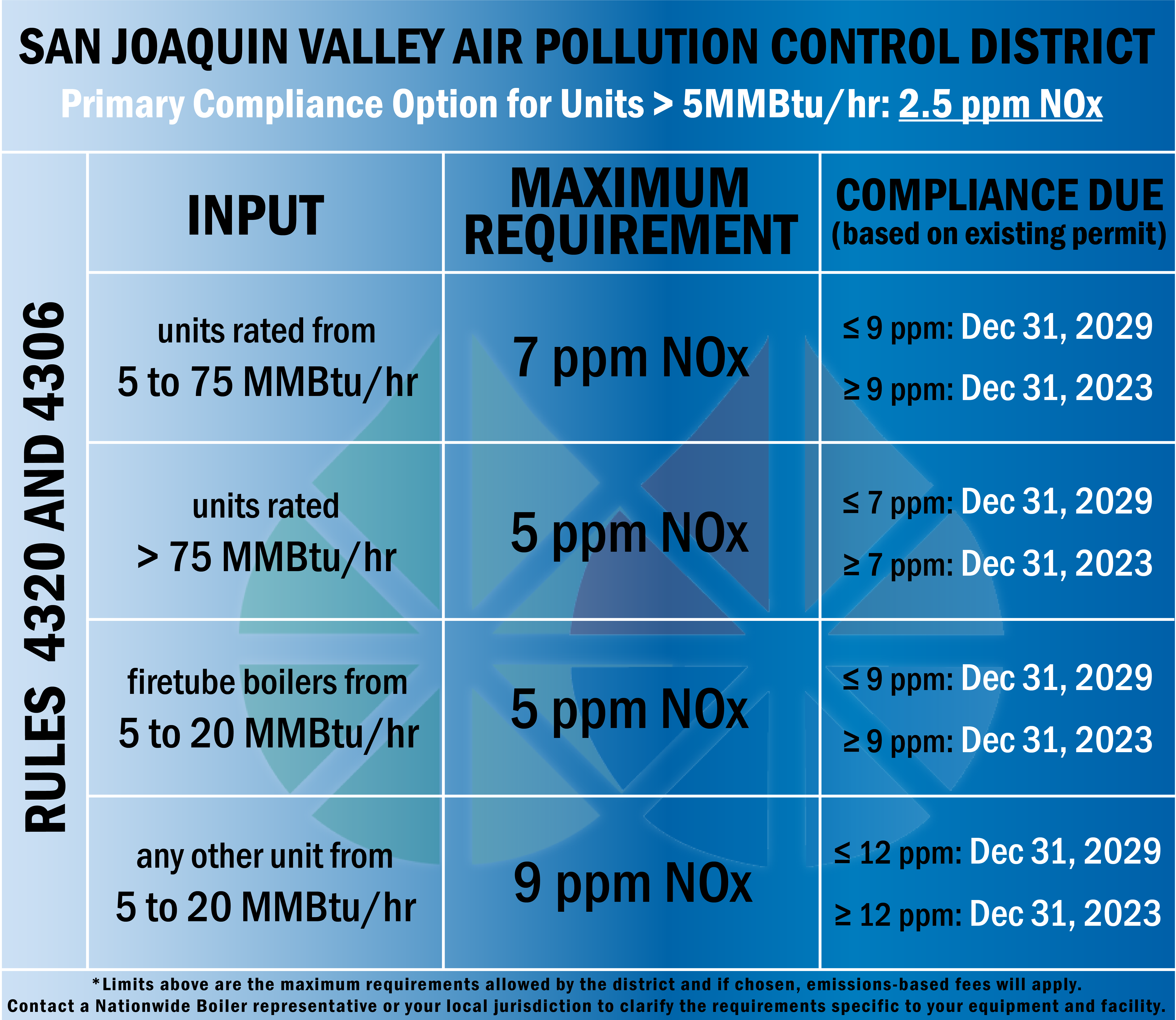 The San Diego County Air Pollution Control District (SDAPCD) works to maintain and constantly improve air quality within the region. The district ensures that commercial, industrial, transportation and agricultural businesses are permitted and comply with the local air pollution regulations, and they incentivize cleaner technologies by offering grant funds.
The San Diego County Air Pollution Control District (SDAPCD) works to maintain and constantly improve air quality within the region. The district ensures that commercial, industrial, transportation and agricultural businesses are permitted and comply with the local air pollution regulations, and they incentivize cleaner technologies by offering grant funds.
Boilers and process heaters with a maximum heat input equal to or greater than 5 MMBtu/hr require a permit to operate from the district. In addition, units capable of being fired on liquid fuel with a maximum heat input of greater than or equal to 1 MMBtu/hr also require a permit to operate. Beginning April 1, 2021, the District will be accepting applications for boilers above 2 MMBtu/hr and less than 5 MMBtu/hr. These “medium size” boilers will require registration or permitting, even if fired exclusively on gaseous fuels.
Whether you are looking for a new boiler to meet the requirements of SDAPCD, or if you have an existing unit that needs to be brought into compliance, Nationwide Boiler can assist. Give us a call today at 800-227-1966
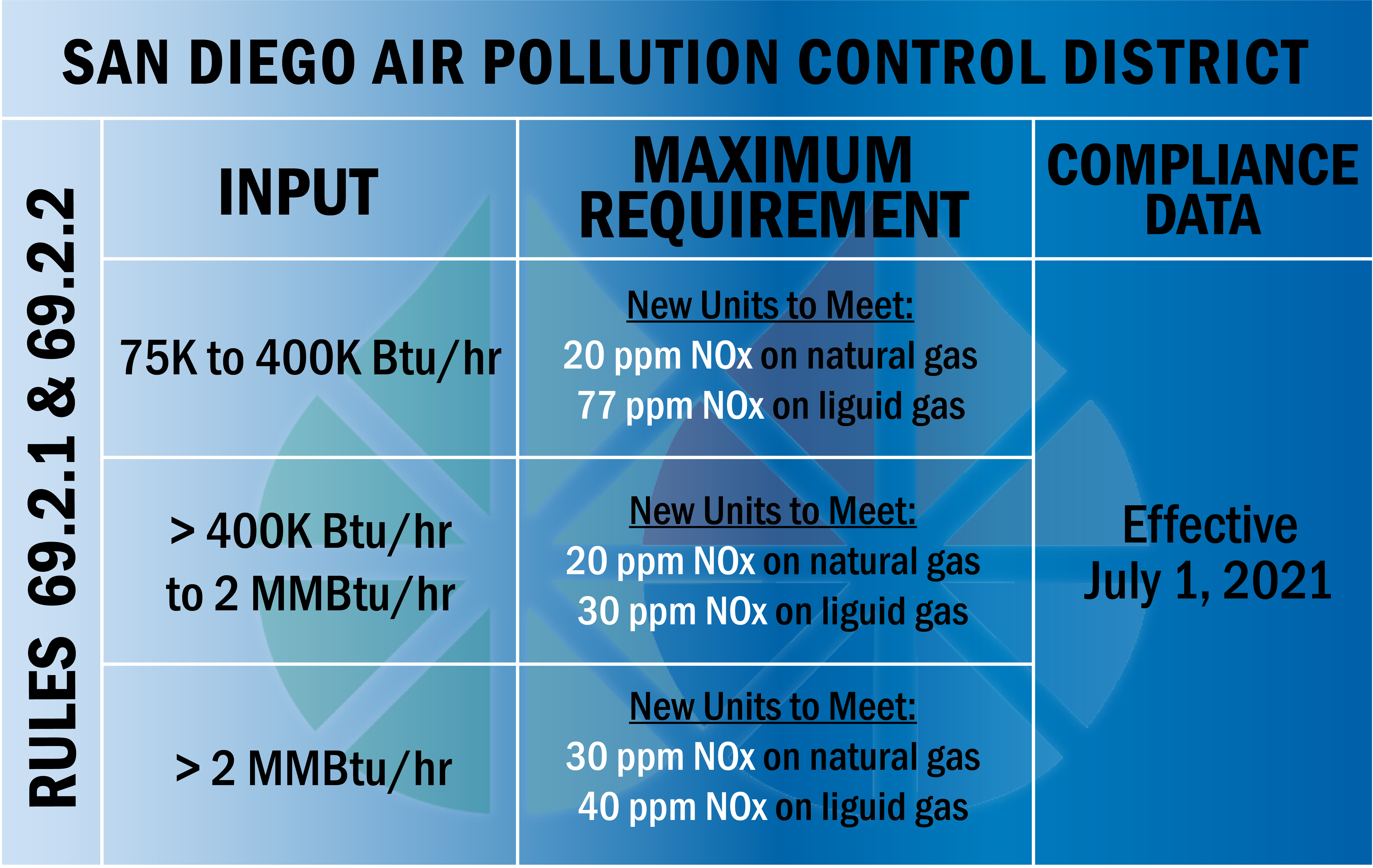
*a non-resettable, totalizing meter is required in each fuel line to measure the mass flow rate of each fuel to the unit; or, a non-resettable, totalizing meter in each fuel line to measure the volumetric rate, temperature, and pressure of each fuel to the unit
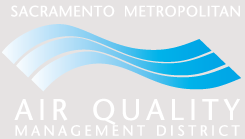 The Sacramento Metro Air Quality Management District (SMAQMD) is responsible for setting forth standards that help clean the air in Sacramento County to meet state and federal health standards. The area's two biggest air pollutants are ground-level ozone and particulate matter. In addition to emission regulations, the SMAQMD works with businesses to provide grant and incentive programs that help local businesses offset the cost of purchasing new and cleaner equipment.
The Sacramento Metro Air Quality Management District (SMAQMD) is responsible for setting forth standards that help clean the air in Sacramento County to meet state and federal health standards. The area's two biggest air pollutants are ground-level ozone and particulate matter. In addition to emission regulations, the SMAQMD works with businesses to provide grant and incentive programs that help local businesses offset the cost of purchasing new and cleaner equipment.
Rule 411 was developed to limit NOx and CO emissions from boilers, steam generators, and process heaters. The requirements of this Rule apply to all units fired on gaseous or nongaseous fuels with a rated heat input of 1 MMBtu/hr or larger.
Whether you are looking for a new boiler to meet the requirements of SMAQMD, or if you have an existing unit that needs to be brought into compliance, Nationwide Boiler can assist. Give us a call today at 800-227-1966
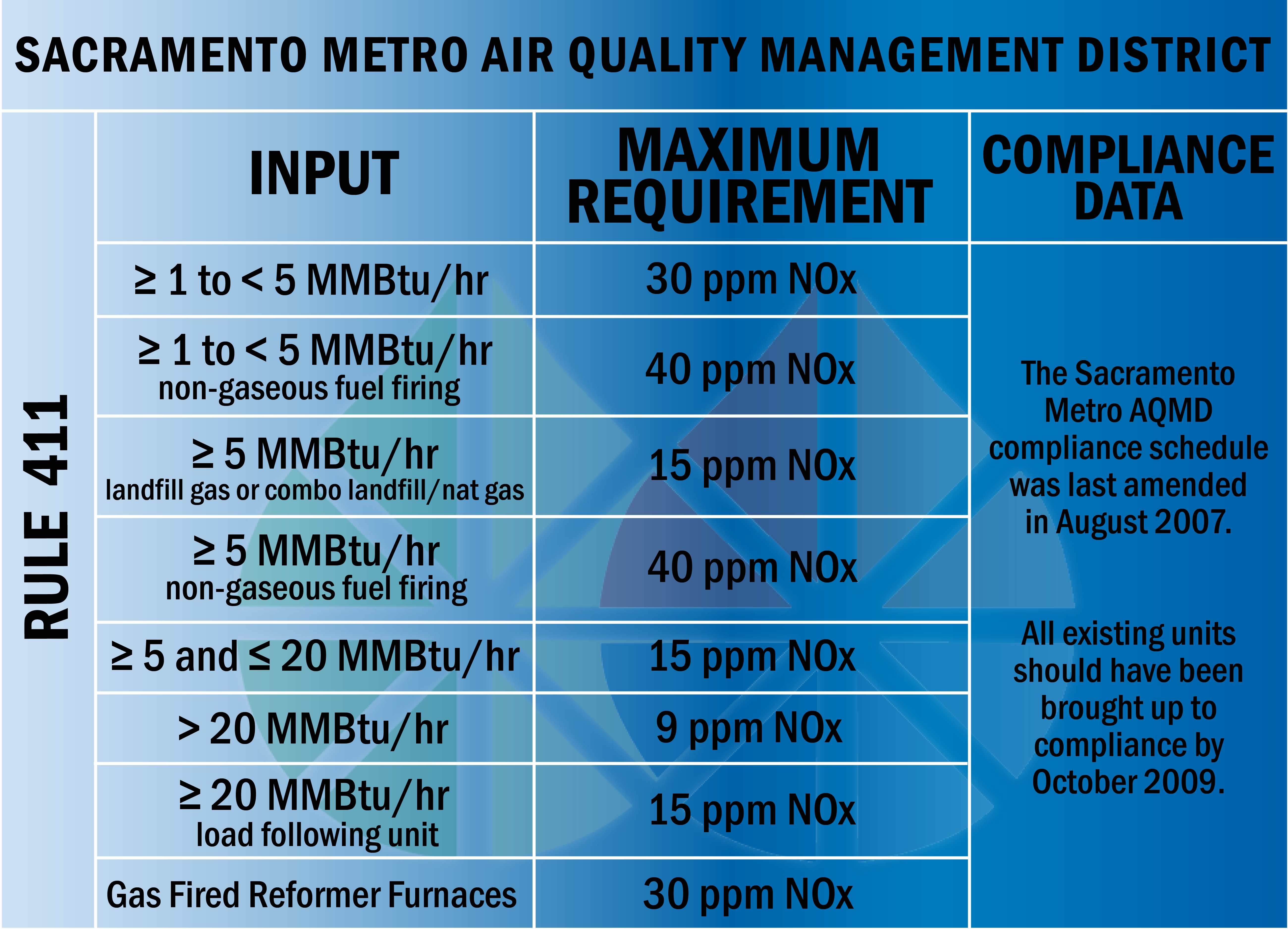
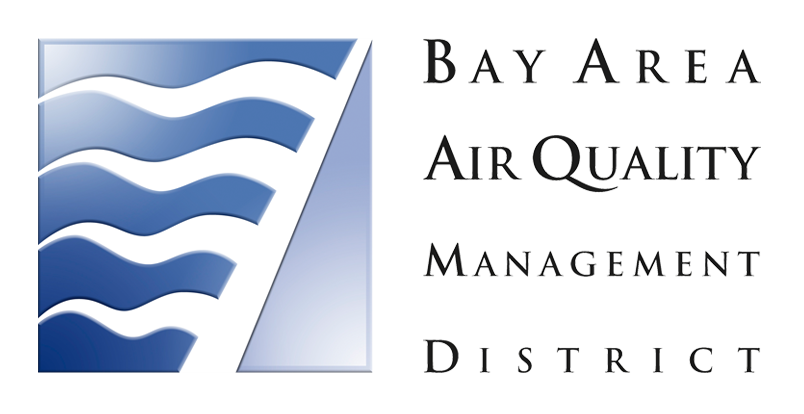 In 1955 the Bay Area Air Pollution Control Law was enacted, and the Bay Area Air Quality Management District (BAAQMD) was formed. Regulations developed by the BAAQMD are based on measures set forth in the Clean Air Plan. These rules are established to help improve public health, air quality, and the global climate.
In 1955 the Bay Area Air Pollution Control Law was enacted, and the Bay Area Air Quality Management District (BAAQMD) was formed. Regulations developed by the BAAQMD are based on measures set forth in the Clean Air Plan. These rules are established to help improve public health, air quality, and the global climate.
Regulation 9, Rule 7 applies to boilers, steam generators, and process heaters, limiting the emissions of NOx and CO from industrial, institutional, and commercial sources. While the rule was first adopted in 1992, it was last amended in 2011 and there have been no changes since then.
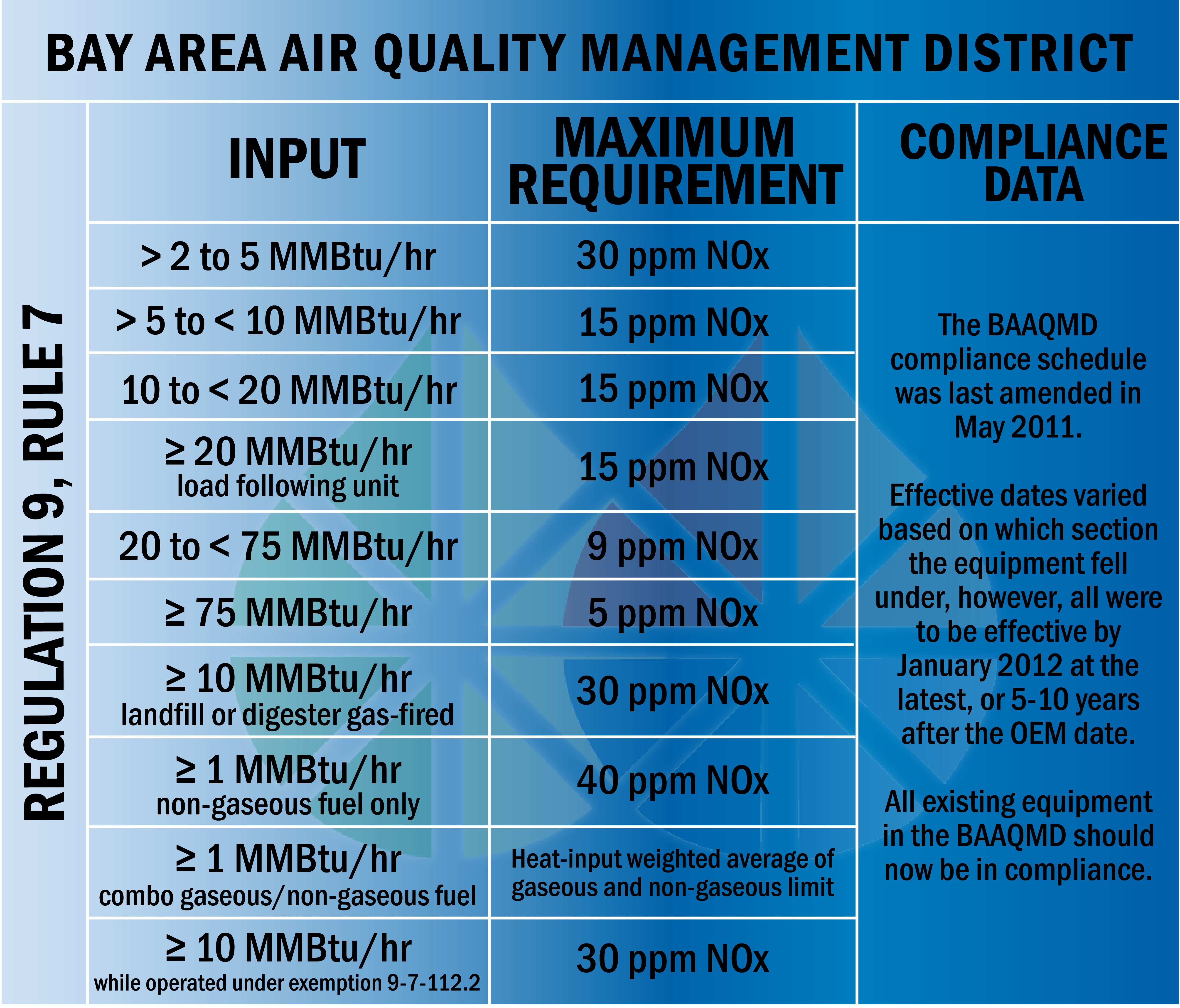
The San Joaquin Valley Air Pollution Control District (SJVAPCD) has recently amended Rules 4306 and 4320 which apply to gaseous or liquid fuel fired boilers, steam generators, and process heaters with a total rated heat input greater than 5 MMBtu/hr. Rule 4306 establishes a maximum NOx limit that units must meet in order to operate within the district, and Rule 4320 establishes more strict NOx limits for units that fall within the category, which are generally technology advancing / forcing. With Rule 4320, operators are given three options to comply:
1. Meet specified emissions limit
2. Pay emissions fee annually to the District
3. Comply with low-use provision (fuel limit of ≤ 1.8 billion Btu/yr)
The primary compliance option, whether governed by Rule 4306 or 4320, is to meet a limit of 2½ ppm NOx by 2023. If compliance is proven at 2½ ppm through source testing, end users will not be subject to any additional emission fees. However, if an alternate compliance option is chosen (5 ppm or 7 ppm NOx based on the table below), end-users may be required to pay additional annual fees of $9,350 per ton of NOx emissions. Fees are based upon the tons of NOx emitted annually, between zero NOx and the permitted NOx limit.
Regardless of which method of control is chosen, the SJVAPCD will require each facility to submit an Emissions Compliance Plan no later than May 1, 2022. Learn more about which category your facility falls into, what your options are, and how Nationwide Boiler can assist with your understanding of these complex requirements as well as preparing the Emissions Compliance Plan.
